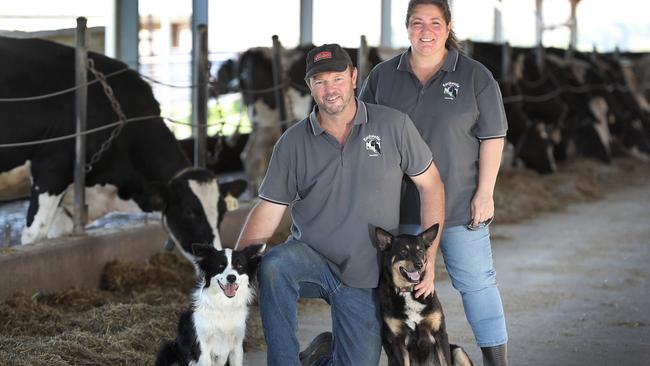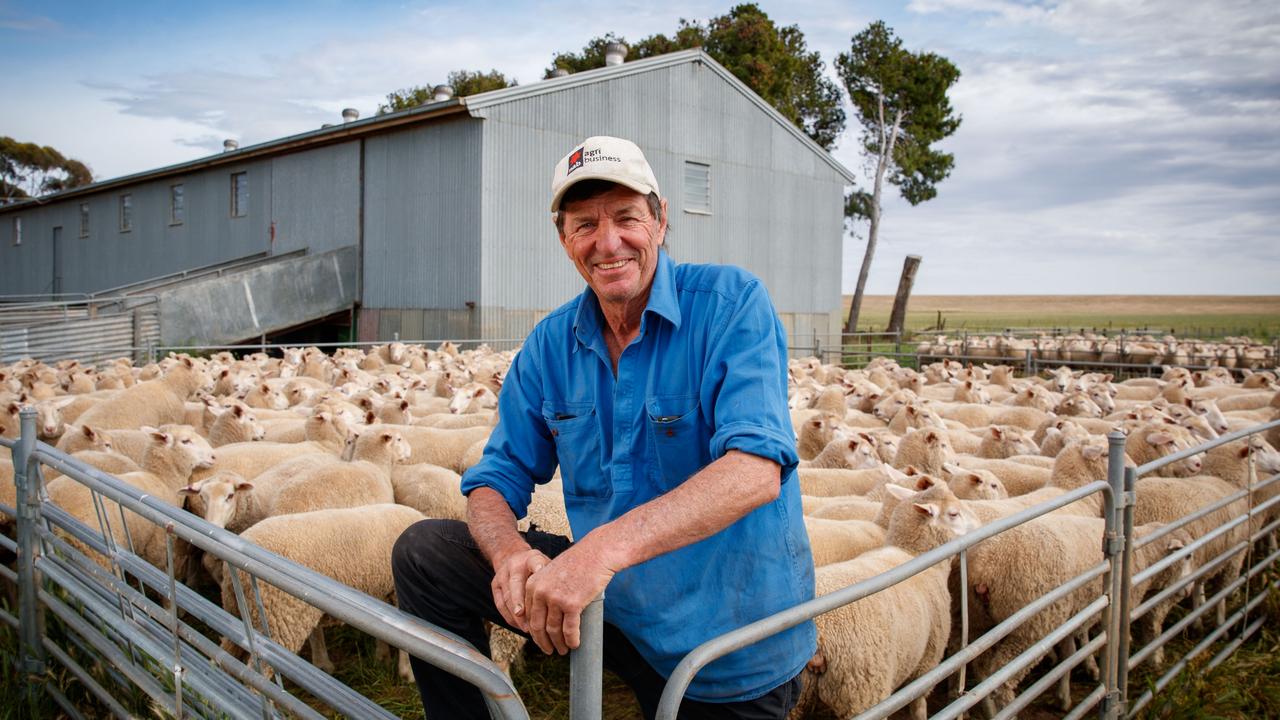Dairy farming: Hurrell family of Torrens Vale in South Australia eye total mixed ration
THE Hurrell family’s dairy cows thrive on a total mix feed ration system, writes SIMONE SMITH.

DAIRY farming in a region where grass is only available for few months of the year requires a different approach.
In fact, for Wes and Rita Hurrell, from Torrens Vale, on South Australia’s Fleurieu Peninsula, the changes they have made to adjust their dairy business to their climate has meant that when grass is available, it can be problematic to their herd of up to 410 cows.
They say, for optimum production, their cows want consistency and grass fails to deliver the same steady diet of a total mix ration system.
“Our season for rainfall is very short in comparison to the Western Districts and Gippsland or other areas of Australia,” Wes said.
“We have a grass period from May through to October at best and really May is a bit questionable. We generally have feed for four months of the year ... in the middle of October the feed quality starts to drop off. The rest of the year, November through to the end of April, we are basically a full TMR, there is very little feed out in the paddock.”
Wes described their cows as “routine creates” whose rumens preferred the same things “day in day out for them to produce what we like”.
“They want consistency — the problem is when you put grass in there it really stuffs up the consistency of that ration,” he said.
“It changes from the time of day, paddock to paddock, and that does cause a lot of issues within the rumen. I reckon it takes closer to six to eight weeks for cows to get used to going back on grass when they have been on a full TMR. We actually drop four to five litres (a cow a day) when we add grass into the ration, we try to balance that up the best way we can.”
GRASS FEVER
THE challenge for the business is to better manage the grass transition.
Wes and Rita, with children Sherrie, 18, and James, 15, use nutritionist Tom Thorn on an “as-needs basis” and say he has been excellent in helping them achieve the maximum production from their herd genetics.
Last year the Hurrells’ cows each produced about 700kg of milk solids with the average weight of their Holstein herd about 650kg. A split calving maintains an even milk flow of 8000-11,000 litres a day. Wes says focusing on per-cow production was the key to making a TMR economically viable.
The Parmalat suppliers have had a concrete feed pad for 13 years.
They built it because they wanted to grow their business without having to move from their home farm.
The investment cost $170,000 and they believe it paid for itself in 2½ years thanks to savings in feed wastage and extra production from the balanced diet provided via a TMR.
“A TMR with 8000 litres a cow is too expensive, it does not work,” Wes said. “ You have to be able to get that 10,000 litres-plus or around that 680-700kg of milk solids to make it viable. Then there’s other benefits from (a TMR operation on a feed pad) as well.
“In our situation, feed wastage was a big one, pasture damage, laneway damage, driving tractors out feeding cows on the paddock. Now we don’t have those issues.”
TECH SAVVY
THE herd is fed to production, with a dairy computer system set at key production points.
The TMR ration in March was 4.5kg of lucerne hay, 1kg of vetch, 12kg of brewers grain (wet), 1.8kg canola, about 7kg of pasture silage, a chopped mixture and round-bale silage. Average cows were each fed about 10kg of grain/concentrate (85 per cent wheat, 15 per cent lupins, about 2 per cent minerals).
A peak cow received close to 16kg/day while the poorest-performing cows received the base rate of about 5kg.
The Holstein herd’s diet is crucial to the Hurrell dairy operation and running a TMR allows them to have an accurate guide for feed costs.
Milking off 103ha, they operate an effective area of 586ha, including land for hay, silage and wheat production as well as a small beef herd.
In the past season the family has made the most of this extra land to cut the costs of feed for the TMR. The Hurrells regularly crunch numbers, calculating the cost effectiveness of buying in feed compared with growing it themselves.
“Wheat this last two years has given us the best gross margin per hectare over doing silage or hay,” Wes said.
“The cost of making chopped silage is quite expensive versus wheat based on the wheat price above $250 a tonne and our costs for growing 4.5-5 tonne/ha yield.
“It is a better return than to grow silage and hay, but this varies year by year.
“Wheat has come back to $200 a tonne, so it might be different this year.”
WHEAT SPOT
FOR each of the past two years, the Hurrells have grown about 70ha of wheat, delivering up to 320 tonnes annually back to the dairy.
From 2014-15 to 2015-16, they were able to decrease their variable costs from $4.61/kg of milk solids to $4.11.
The South Australian Dairy Farm Monitor Project average is $3.62.
The family has also been able to trim its bought-in feed costs thanks to the negotiation of “fairly good long-term deals” and the addition of a 257ha sheep farm two years ago, which increased the size of the farm to 586ha.
They still buy good quality lucerne, vetch or medic hay when required.
A $110,000 investment in a 90-kilowatt solar system cut 14c/kg of milk solids from their variable costs, reducing their power bill from $45,000 to $20,000 a year.
The Hurrells’ cost of production in 2015-16 was $5.53/kg of milk solids, including inventory changes (a lot of feed was carried across to the next season), with total operating costs at $6.61/kg of milk solids. This compared with a state average cost of production of $5.97/kg of milk solids and average operating costs of $6.07/kg of milk solids.
Their total income for 2015-16 was $8.03/kg of milk solids, compared with a state Dairy Farm Monitor Project average of $6.82/kg of milk solids. This included livestock sales.
Operating the Rockwella Farm Holstein stud has enabled the Hurrells to add an extra 8-10c/litre to their bottom line through sales of stud bulls, six to 12-month-old export heifers and in-milk livestock.
Livestock sales have not played a big role in the business over the past 12 months, but with an extra 100 milkers this season, and improved export heifer prices, they hope to take advantage of these markets again.
YES SIRE
ABOUT 80 per cent of the Holstein semen bought is from genomic sires with a specific focus on type, udder conformation, sound feet and legs and capacity. Production is also important as are health traits.
The heifers are generally inseminated with sexed semen, but if they are inseminated with conventional semen it is genomic with a strong focus on calving ease.
“Going forward we want to use the genetic base of a herd a little better,” Wes said.
“For example, genomically testing our young stock. It would give us a little more of an edge for breed selection (and allow us) to identify which ones to breed from and which ones we could probably put the beef bull over.”
Recently the Hurrells have joined their poorer-performing cows to Wagyu bulls, taking advantage of the Dairy Beef Alliance market. Both male and female Wagyu-cross calves are worth $300 at a week old rather than the $30-$40 paid for similar aged Holstein bulls.
The Hurrells also have the option to take the cattle through to 10 months of age and receive a 45 per cent premium price to the Eastern Young Cattle Indicator.
The family have also diversified into beef to make the most of the additional land not required for dairy. They run a 50-75 cow herd made up of Angus, Hereford and their crosses.
“(Dairy and beef) can work hand-in-hand nicely,” Wes said. “Obviously with dairy cows we can develop a pretty good beef herd through that. It is diversifying but still using our core business to be able to make that grow. Whether that be Wagyu or beef-cross over the Holsteins or making our own beef herd grow.”
STEAK OUT
WES said the diversification into beef was a reaction to lower milk prices and higher beef prices.
“We will have something up and going (the beef business) if dairy prices don’t improve and if dairy companies don’t have an understanding they need to pay a fair and reasonable price,” he said.
Looking ahead, Wes said he would love to build a barn and maintain a year-round TMR, but conceded the return on the asset was “not there” compared with buying another block of land. The typography of the farm — its undulating and gets “very wet” in winter — means grazing cows has to continue rather than operating a full “cut and carry” TMR system.
Dabbling in a bit of summer forage, the family have sown 4ha of irrigated lucerne as a way spread their feed base out.
The Hurrell business now looks incredibly different to the “small family farm with a single block” Wes returned home to 30 years ago. He and Rita officially took over in 2011.
Taking opportunities has been a key to the changing face of the business. “Whatever we do, it has got to make money and enhance the business we have got,” Wes said.


